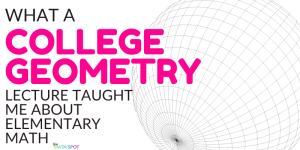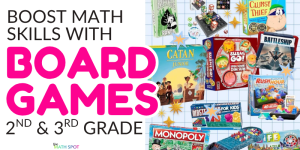A few weeks ago, I went to a conference where it felt like every presenter started their session the same way. They would say something like, “Pretend you don’t know how to solve this,” and then walk us through manipulatives, models, or routines that would help a student who truly didn’t know how to solve that math idea.

It was good work, but after a few sessions of pretending not to understand things I knew I wanted a different experience. I wanted to actually feel what it is like to be the learner who doesn’t know. I wanted to notice what helped me hold on and what caused me to slip off the ladder completely.
So for my last session of the conference, I took a big risk. I chose a session led by a college professor. The description made it very clear that we were headed far beyond my comfort zone:
“This session will look at dissection theory, which allows us to transform polygons in the Euclidean plane into rectangles of the same area. We’ll prove some theorems about scissors congruence and make some connections to area in hyperbolic geometry if time allows.”
Let me be clear: I know elementary math deeply and confidently. But once we move beyond that world, I’m a deer in headlights. This made this session the perfect place to pay attention to myself as a learner.
And really, truly, I absolutely loved it.
What Helped Me Learn
I was truly surprised that I kept up with about eighty-five percent of the session. It was engaging, challenging, and the scaffolds I needed were in place.
Here’s what made learning possible for me:
I had something familiar to connect to.
When an idea was anchored in something I already understood, I could follow along. Any time the professor tied a new thought back to something more grounded, I was able to connect to that idea and keep up.
There were only about 8 of us in the room and I was very up front with the professor about the experiment I was running. The presenter was from my college alma mater and was more than supportive of this idea, so he checked in often to be sure that I was working from a place of understanding.
The session was conversational.
Instead of giving us steps or a formal proof, he would pose a big idea, invite questions, and let us toss around our own thinking. We were having a conversation and testing ideas. We were hearing how others made sense of the same concept. There were even a few times where my lack of formal knowledge allowed me to “see things” that the others couldn’t see which was really interesting to me!
There were models. Lots of them.
Even at the college level, we weren’t living in the abstract world. We had diagrams, visual references, and representative models to ground our thinking.
And Then I Got Lost
The turn came a bit after we moved into hyperbolic geometry. At first, I was still keeping up. It was exhilarating 😂. I had no business understanding hyperbolic geometry, and yet there I was, hanging on.
And then we shifted into three-dimensional thinking in that same space. Suddenly, he was referencing equations I had no fluency with. The diagrams disappeared. The anchor points were gone. And the end of the session was drawing near so the pace picked up.
I was floating in pure abstraction, and that was the moment my brain bowed out.
Was I frustrated? Not even a little bit.
This was exactly what I went to the session for. I wanted to feel what our students feel. I wanted to experience the moment when support is strong and learning feels possible, and the moment when the scaffolds fall away and understanding slips through your fingers.
And I did.
But if I was a student who had been expected to master that content and the class was marching on while I was sitting there wondering how they all knew that formula… and what was that formula again? I absolutely would have had a moment of panic. Once my footing started to slip, it was a hard and fast fall.
What This Means For Our Classrooms
Walking out of that session, the connections to elementary teaching couldn’t have been clearer.
1. Anchor new learning in prior knowledge.
Students can take huge leaps when ideas are tied to something familiar. Without that grounding, the leap is simply too far.
2. Support understanding with visuals, models, and hands-on tools.
Do not rush students into the purely abstract world. The concrete and representational stages aren’t baby steps. They’re the bridge.
3. Don’t rush to the algorithm. Invite thinking.
Discussion matters! Let students ask questions, test ideas, and talk their way through the math.
This session gave me exactly what I hoped for: a chance to study myself as a learner and walk away with a clearer picture of what helps students learn and what causes them to stall.



